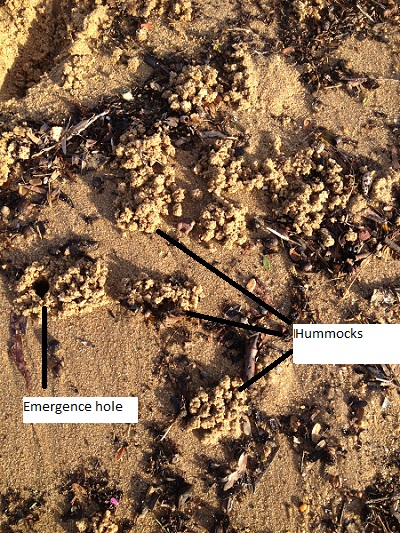Feeding
Solider crabs feed on organic matter found within the
sediment. Organic matter consumed includes chlorophyll, organic carbon and nitrogen
(Webb & Eyre, 2004).The exploration of gut contents found the source of
nutrients to be organisms such as gastropod eggs nematodes, as well as various
small phytoplankton such as diatoms(Cameron, 1966). Remarkably only a small
amount of silt and no sand grains were found in the contents of M. longicarpus’
gut and faecal pellets (Cameron, 1966).
Feeding occurs during periods of low tide and is often referred
to as intensive grazing (Webb & Eyre 2004). Grazing occurs either just
below the surface through the assembly of horizontal galleries (hummocks) or
armies will emerge from burrows and feed on surface sediment that is deemed to
be of a suitable moisture (Cameron, 1966; Webb & Eyre, 2004). Regardless of feeding strategy, solider crab populations
simultaneously feed on the top few centimetres of the intertidal sediment
surface for a variable period of time, from one hour to two and a half hours (Cameron,
1966). During this time crabs can traverse up to 450 meters, it is suggested
this movement during the feeding phase is to find sediment of a suitable moisture
content (Cameron, 1966) and to avoid food exhaustion in a localised area (Dittmann,
1993).

Original photo taken by Kate Buchanan, 2014. With reference to Cameron 1966.
As M. longicarpus is selective in the organic debris it engulfs,
it is termed an indiscriminate feeder. It is due to this sorting that allows
the solider crab to intensively feed for up to two hours and not accumulate
sand within its gut (Webb & Eyre, 2004). Before sediment reaches the buccal
cavity it is examined by various mouthparts. The material deemed unsuitable for
consumption accumulates into small pellets at the base of the third maxillipeds
(Cameron, 1966). These pellets are dropped off by a swipe from the chelae. This
need for a moist substrate is due to the use of water in the buccal cavity. As
food enters the buccal cavity, water is added allowing lighter particles,
generally organic matter, to float and heavier particles such as sand to sink (Webb
& Eyre 2004). The floating particles are ingested while the particles that
sink are released as a pseudofeacal pellet (Cameron, 1966).
M. longicarpus feeding habits play an important role in
nutrient cycling, as it has been found to have a significant effect on sediment
metabolism, by reducing the fluctuations of solutes across the boundary of the
sediment and water (Webb & Eyre, 2004). A 1986 study by Quinn found that
after surface grazing, the amount of organic matter and nitrogen in the
sediment had decreased by 3.7% and 7.7% respectively. Similar results were
found when solider crabs fed in hummocks, with organic matter content
decreasing by 7.2% and nitrogen content decreasing by 5% (Quinn, 1986). When M. longicarpus is lost in an ecosystem,
this cleaning of the sediment is gone too, which results in a decrease of
nitrogen and carbon uptake, resulting in a loss of these important nutrients into
the system (Webb & Eyre, 2004).
|